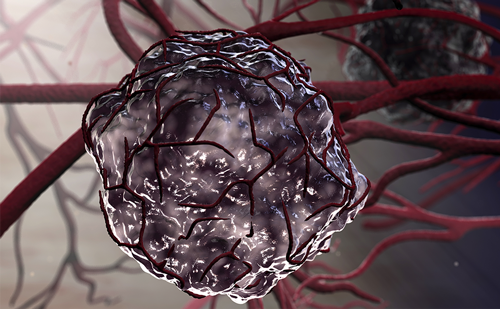Colorectal cancer (CRC) is the third most common cancer among men and women and the second leading cause of cancer death in the Western world.1 Nearly 25% of all patients have metastatic disease at initial diagnosis, with a five-year survival rate of less than 10%.1 In addition, despite curative surgery, around 40–50% of these patients will still relapse within three years of primary surgery. Over the last four decades, 5- fluorouracil (5-FU) has been the cornerstone for CRC treatment in both the palliative and the adjuvant setting. The introduction of new cytotoxic drugs such as capecitabine, irinotecan and oxaliplatin, the integration of biological agents such as cetuximab and bevacizumab and the development of new agents acting on novel targets has clearly increased the number of therapeutic options for patients with advanced and metastatic CRC disease.
Systemic Treatment of Metastatic Disease
The incorporation of new chemotherapeutic and biological agents has raised many important questions and challenges concerning the most effective chemotherapy combination, optimal duration of treatment, optimal use of one or two biological agents in combination chemotherapy and the best sequence.
Combination Chemotherapy
Until the 1990s, the only available drug was 5-FU, with modest activity (response rate [RR] 20–25%, median overall survival [mOS] 13 months) when combined with the biomodulator folinic acid (FA) and delivered as a prolonged infusion2,3 (see Figure 1). More recently, the oral fluoropyrimidine capecitabine has been shown to be as active as bolus 5-FU/FA.4 The first real advance came with the addition of irinotecan (FOLFIRI) or oxaliplatin (FOLFOX) to infusion-based 5-FU/FA with response rates in the 40–50% range and mOS times of 17–19 months5,6 (see Figure 1). The cross-over study, conducted by Tournigand et al., provided evidence for increased OS when patients were exposed sequentially to FOLFIRI followed by FOLFOX (mOS 21.5 months) or to FOLFOX followed by FOLFIRI (mOS 20.6 months).7
In a randomised phase III trial, the triplet combination of irinotecan, oxaliplatin and 5-FU/FA (FOLFOXIRI) was found to be superior to FOLFIRI as first-line treatment with median survival times of 22.6 versus 16.7 months, respectively.8 In contrast to this study, the phase III trial presented by Souglakis et al. failed to demonstrate any superiority of the FOLFOXIRI arm over the FOLFIRI arm.9 Phase II studies with infusional 5-FU/FA and bolus mitomycin-C have shown modest activity with response rates of 12–17% in chemo-resistant CRC patients.
Another important challenge has concerned treatment duration: should patients be treated until disease progression, until maximal response or to only a pre-defined dose-limit? In this respect, the OPTIMOX1 trial showed that a planned interruption of oxaliplatin does not compromise the overall efficacy of the treatment.10 Similarly, a study comparing intermittent FOLFIRI with continuous FOLFIRI administered until disease progression has shown overall survival rates of 16.9 versus 17.6 months, respectively.11 Ongoing trials such as COIN and CONcePT will further evaluate the approach of treatment interruption.
The Role of Biological Agents Antiangiogenic Agents
Vascular endothelial growth factor (VEGF) has been identified as a key mediator of angiogenesis, a process essential for growth of tumours and metastasis. Thus, it has become a target for anticancer therapy.12 The antitumour activity of bevacizumab (Avastin), a humanised IgG1 monoclonal antibody (MAb) directed against VEGF, in combination with first-line chemotherapy has been studied in several phase II–III trials in patients with metastatic CRC.
Bevacizumab in Chemo-naïve Colorectal Cancer Patients Hurwitz et al. reported a median survival of 20.3 months for patients receiving bevacizumab in combination with IFL compared with 15.6 months for those receiving IFL alone13 (see Figure 1). Based on this clinical trial, bevacizumab has been approved by the US Food and Drug Administration (FDA) for the first-line treatment of metastatic colorectal cancer. As bolus administration of 5-FU/LV is considered inferior to infusional 5 FU/LV regimens, recent studies such as the BEAT and BriTE trials have focused on the combination of bevacizumab with the infusional regimens FOLFIRI, FOLFOX and XELOX. Preliminary data of a phase II study of bevacizumab in combination with FOLFIRI showed a median progression-free survival of 12.5 months.14 The randomised Three Regimens of Eloxatin Evaluation (TREE 1 and TREE 2) trials compared three oxaliplatin-based regimens with or without the addition of bevacizumab. Preliminary results demonstrated an overall response of 52% for patients treated with mFOLFOX plus bevacizumab compared with 41% for patients treated with mFOLFOX alone.15 Preliminary data of the XELOX-1/NO16966 randomised phase III trial showed a median progression-free survival of 10.4 months for patients receiving FOLFOX-4 or XELOX plus bevacizumab compared with 8.1 months for the chemotherapy arm alone.16 There was no benefit in response rate for the chemotherapy plus bevacizumab arm. An important and not yet resolved question is whether bevacizumab should be continued following initial response or given as stabilisation to first-line combination bevacizumab–chemotherapy treatment.
Bevacizumab in Chemo-resistant Colorectal Cancer Patients
Several studies have shown that bevacizumab as monotherapy or in combination with bolus 5-FU/LV is not active in heavily pre-treated patients.17 A large, randomised, multicentre phase III trial (E3200) showed that bevacizumab plus FOLFOX-4 significantly extended mOS (12.5 versus 10.7 months), progression-free survival (7.2 versus 4.8 months) and overall response rate (21.8 versus 9.2%) compared with the FOLFOX-4 arm alone in CRC patients previously treated with 5-FU and irinotecan.18 On the basis of this trial, the FDA approved bevacizumab in combination with 5-FUbased chemotherapy in the second-line treatment of metastatic CRC. Preliminary results of a phase II study of bevacizumab in combination with irinotecan/LV/5-FU in CRC patients refractory to an oxaliplatin-based regimen showed a response rate of 37.5 % and time to progression of eight months.19
Other antiangiogenic agents currently under clinical investigation in metastatic CRC are the soluble decoy receptor VEGF-trap and the VEGFR tyrosine kinase inhibitors (TKIs) PTK787/ZK 222584 (PTK/ZK, vatalanib), sunitinib malate (SUTENT), AZD6474 (Zactima) and AZD2171 (Recentin). In contrast with the data for bevacizumab, two randomised phase III trials of valatinib, a combined VEGFR1/VEGFR2/PDGFR/c-Kit inhibitor, performed in chemo-naïve (CONFIRM-1) and irinotecan-pre-treated (CONFIRM-2) patients, failed to meet their primary end-point. An interim analysis of CONFIRM-1 revealed that FOLFOX-4 plus valatinib did not improve progression-free survival compared with FOLFOX-4 alone (7.7 versus 7.6 months).20 Similarly, interim results from CONFIRM-2 showed that valatinib did not improve response rate (18% in the placebo arm versus 19% in the valatinib arm) or overall survival (11.8 months in the placebo arm versus 12.1 months in the valatinib arm), but a small increase in progression-free survival was observed (4.1 months in the placebo arm versus 5.6 months in the valatinib arm p=0.026).21 The ongoing Horizon I phase II study is comparing the combination of FOLFOX plus VEGFR1/2/3 TKI AZD2171 or bevacizumab in the second-line treatment of patients with metastatic colorectal cancer.
Epidermal Growth Factor Receptor-targeted Therapies
Epidermal Growth Factor Receptor Monoclonal Antibodies in Chemo-naïve Colorectal Cancer Patients
Several phase I/II studies have shown high levels of activity when cetuximab (C225, Erbitux), the immunoglobulin (Ig)G1 epidermal growth factor receptor (HER1) chimeric MAb, is combined with an irinotecan- and oxaliplatin-containing regimen, with response rates of 46–74% and 54–72%, respectively. Interestingly, the trials reported by Folprecht et al., Seufferlein et al. and Diaz-Rubio et al. showed that treatment with cetuximab-based chemotherapy facilitated resection of liver metastases.22–24 Combining the fully human IgG2 anti-HER1 MAb panitumumab with IFL or FOLFIRI was associated with response rates of 47 and 33%, respectively.25
Phase III randomised trials, such as the COIN, CALGB 80203 and CRYSTAL studies, investigating the activity of cetuximab in combination with chemotherapy in the first-line treatment of metastatic CRC cancer are under way. The CRYSTAL study is comparing the addition of cetuximab to FOLFIRI with FOLFIRI alone in EGFR-expressing CRC patients. Preliminary data from the CRYSTAL study revealed an increased progression-free survival of patients treated with FOLFIRI–cetuximab compared with FOLFIRI alone.
Epidermal Growth Factor Receptor Monoclonal Antibodies in Chemo-resistant Colorectal Cancer Patients
In contrast to bevacizumab, several phase II trials have demonstrated that cetuximab reverses chemo-resistance when combined with irinotecan in irinotecan-refractory patients.26,27 Furthermore, both cetuximab and panitumimab have single-agent activity in heavily pre-treated CRC patients.26 Similarly to bevacizumab, cetuximab has been shown to increase the activity of an active regimen in the second-line treatment of CRC. The EXPLORE trial compared a combination of cetuximab plus FOLFOX-4 with FOLFOX-4 in patients with metastatic EGFR-positive CRC that had progressed on prior first-line irinotecan treatment, and response rates of 21 and 10% for combination and monotherapy, respectively, were recorded.28
A number of phase III trials (EPIC study, AMGEN nr 20050181) are currently comparing the combination of an EGFR MAb (cetuximab or panitumimab) with irinotecan versus irinotecan in patients who had progressed on an oxaliplatin-based regimen.
In contrast to the HER1 MAbs, phase II studies have shown that the single-agent HER1-targeted TKIs gefitinib and erlotinib have no substantial activity in chemo-refractory metastatic CRC.29 While gefitinib has been shown to improve the efficacy of an oxaliplatin-containing regimen as first- and second-/third-line treatment,30,31 combining EGFRtargeted TKIs with irinotecan seems to be an inferior option in CRC.32
Other TKIs with inhibitory activity against both HER1 and HER2, such as lapatinib and CI-1033, are under clinical investigation.
Combination of Epidermal Growth Factor Receptor and Vascular Endothelial Growth Factor-targeted Therapies
The intriguing results of the BOND study, as well as the pre-clinical data showing a synergistic growth inhibition of bevacizumab in combination with cetuximab, have led to the design of trials that analyse the activity of bevacizumab plus cetuximab or panitumimab in first- and second-line treatment of CRC. In the ongoing CALGB 80405 phase III trial, chemonaïve patients receiving FOLFOX or FOLFIRI (according to the centre’s preference) are randomised to receive cetuximab or bevacizumab alone or a combination of both cetuximab and bevacizumab. Promising data from a small randomised phase II trial (BOND II) have shown increased response rate (37 versus 20%) and time to progression (7.9 versus 5.6 months) when bevacizumab was added to cetuximab and irinotecan in irinotecan-refractory CRC patients.33
Best Combination and Optimal Sequence for Epidermal Growth Factor and Vascular Endothelial Growth Factor-targeted Therapies
The phase III trial by Hurwitz et al.13 has been the basis for the use of bevacizumab in combination with an active chemotherapeutic regimen in the first-line treatment of patients with metastatic CRC. In view of the BOND studies, the combination of cetuximab plus irinotecan is frequently applied in chemo-refractory CRC.26,33 Depending on the performance status of these patients and the potential existence of contraindications for these therapeutic options, several treatment continuum options to extend survival can be recommended (see Figure 2).
Beyond Epidermal Growth Factor Receptor and Vascular Endothelial-targeted Therapies – Novel Pathways and Agents
Recent advances have been made in the clinical development of therapies designed to inhibit the function of a number of important signalling proteins (see Figure 3). Other membrane TK receptor targets are the insulin-like growth factor receptor (IGFR) and the platelet-derived growth factor receptor (PDGFR). Several antibody and/or small-molecule inhibitors of both receptors have recently entered clinical trials (see Table 1). A number of monoclonal antibodies targeting apoptotic pathways are under clinical investigation. Mapatumumab (HGS- ETR1, TRM-1 MAb) and HGSETR2 are both agonist monoclonal antibodies to TRAIL-R1 and TRAIL-R2, both death receptors that enhance apoptosis upon binding of their ligand TRAIL (see Table 1). Clinical trials with these agents, as well as with a recombinant version of TRAIL ligand itself (Apo2L/TRAIL), are under way.
Furthermore, several compounds targeting proteins that mediate the extrinsic and mitochondrial death pathway such as B-cell lymphoma 2 (Bcl2) and poly (ADP-Ribose) polymerase (PARP) inhibitors are under clinical investigation (see Table 1).
A number of agents were designed to target downstream signalling key targets. Several approaches to inhibit Ras (farnesyltransferase inhibitors, antisense molecules) and Raf failed in the clinic. The multikinase inhibitor sorafinib, several MEK1/2, PI3K, Akt and mammalian target of rapamycin (mTOR) inhibitors are under pre-clinical or clinical investigation (see Table 1). Recent attention has been garnered by the non-receptor TK c-Src as an interesting target and a number of phase I/II studies with Src inhibitors are ongoing. The heat–shock protein HSP90 plays an important role in the folding, intracellular disposition and proteolytic turnover of many key regulators and cell growth differentiation and survival. Several phase I trials with small-molecule HSP90 inhibitors, such as 17-DMAG, are ongoing. The Aurora serine/kinase family are key regulators of the mitosis and a number of pan-Aurora kinase inhibitors are currently being investigated in phase I studies (see Table 1).
Adjuvant Treatment of Colorectal Cancer Combination Chemotherapy
Based on the data from the INT-0089 trial, bolus 5-FU/LV for six months has been accepted for the adjuvant treatment of stage III colon cancersince the mid-1990s.34 Three randomised studies compared infusional with bolus administration of 5-FU as adjuvant treatment in stage II–III CRC patients. No difference in disease-free survival (DFS) or OS for any arm was seen; however, continuous infusion of 5-FU had a more favourable toxicity profile.35–37 Following this, the X-ACT trial showed a trend towards superior DFS (p=0.0528) and OS (p=0.0706) for capecitabine compared with bolus 5FU/LV in stage III CRC patients.38 The large-scale QUASAR study of adjuvant chemotherapy versus observation showed a small (3–4%) benefit in five-year survival for stage II CRC patients.39 Recently, oxaliplatin and irinotecan in combination with a 5- FU-containing regimen have been evaluated in the adjuvant setting. The MOSAIC trial compared FOLFOX4 with infusional 5FU/LV (De Gramont) in stage II–III CRC patients. Only stage III patients benefited from the addition of oxaliplatin to 5FU/LV with a significant difference in four-year DFS of 8.6% (7.2% for N1 disease and 11.2% for N2 disease). In patients with high-risk stage II disease (T4, G3, bowel obstruction, tumour perforation, vascular invasion and number of lymph nodes examined <10), a 5.4% difference in DFS was found between the two groups.40 In contrast to the oxaliplatin trials, three randomised trials (PETACC-3, ACCORD-02, CALGB 89803) failed to show any benefit in terms of DFS in favour of irinotecan.41–43 Figure 4 presents one algorithm for the adjuvant treatment of patients with stage II and III CRC. It is important to note that only one-third of the 40% of patients who are at risk of relapse derive any significant benefit from adjuvant chemotherapy treatment.
The Role of Biological Agents
Based on the activity of bevacizumab and cetuximab in combination with chemotherapy in the metastatic setting, several ongoing trials are evaluating the effectiveness of bevacizumab or cetuximab as adjuvant treatment (see Table 2).
Conclusion
HER- and VEGF-targeted MAbs have clearly increased the therapeutic armamentarium of patients with metastatic CRC. Large-scale phase III studies determining their role in the adjuvant setting are ongoing. Several new agents targeting signalling molecules that play a crucial role in the proliferation, survival and invasion of cancer cells are being investigated in phase I trials of patients with metastatic CRC. The major challenge for the future is to identify patients who will benefit and patients who are most likely to experience adverse side effects on the basis of their molecular and/or genetic profile. ■
The Management of Colorectal Cancer – The Integration of Biological Agents and Identification of New Targets
Article
References
- Bleiberg H, et al., Colorectal cancer, a clinical guide to therapy, Martin Dunitz Ltd, 2002.
- Meta-analysis Group in Cancer, J Clin Oncol, 1998;16:301–8.
- Advanced Colorectal Cancer Meta-analysis Project, J Clin Oncol, 1992;10:896–903.
- Mayer, J Clin Oncol, 2001;19(21):4093–6.
- Douillard JY, et al., Lancet, 2000;355:1041–7.
- de Gramont A, et al., J Clin Oncol, 2000;18:2938–47.
- Tournigand C, et al., J Clin Oncol, 2004;15(22):229–37.
- Falcone A, et al., ASCO GI annual meeting, 2007; abstract 287.
- Souglakos J, et al., Br J Cancer, 2006;27(94):798–805.
- Tournigand C, et al., J Clin Oncol, 2006;20(24):394–400.
- Labianca R, et al., ASCO annual meeting, 2006; abstract 3505.
- Jain RK, Semin Oncol, 2002;29(Suppl. 16):3–9.
- Hurwitz HI, et al., J Clin Oncol, 2005;20(23):3502–8.
- Kopetz S, et al., ASCO annual meeting, 2006; abstract 3479.
- Hochster HS, et al., ASCO annual meeting, 2006; abstract 3510.
- Saltz LB, et al., ASCO GI annual meeting, 2007; abstract 238.
- Chen HX, et al., ASCO annual meeting, 2004; abstract 3515.
- Giantonio BJ, et al., ASCO annual meeting, 2005; abstract 2.
- Samelis GF, et al., ASCO annual meeting, 2007; abstract 394.
- Hecht JR, et al., ASCO annual meeting, 2005; abstract 3.
- Koehne C, et al., ASCO annual meeting, 2006; abstract 3508.
- Folprecht G, et al., ASCO annual meeting, 2005; abstract 3640.
- Seufferlein T, et al., ASCO annual meeting, 2005; abstract 3644.
- Díaz Rubio E, et al., ASCO annual meeting, 2005; abstract 3535.
- Hecht J, et al., ASCO annual meeting, 2006; abstract 237.
- Cunningham D, et al., N Engl J Med, 2004;351:337–45.
- Grothe W, et al., 2005; ASCO annual meeting, abstract 3669.
- Jennis A, et al., ASCO annual meeting, 2005; abstract 3574.
- Rothenberg ML, et al., J Clin Oncol, 2005;23:9265–74.
- Fisher GA, et al., 2004; abstract 3514.
- Kuo T, et al., J Clin Oncol, 2005;23:5613–19.
- Redlinger M, et al., ASCO annual meeting, 2004; abstract 3767.
- Saltz LB, et al., ASCO annual meeting, 2005; abstract 3508.
- Haller DG, et al., J Clin Oncol, 2005;1(23):8671–8.
- Andre T, et al., J Clin Oncol, 2003;21:2896–2903.
- Chau I, et al., Ann Oncol, 2005;16:549–57.
- Poplin EA, et al., J Clin Oncol, 2005;23:1819–25.
- Twelves C, et al., N Engl J Med, 2005;352:2696–2704.
- Gray RG, et al., ASCO annual meeting, 2004; abstract 3501.
- De Gramont A, et al., ASCO annual meeting, 2005; abstract 167.
- Van Cutsem E, et al., ASCO annual meeting, 2005; abstract 8.
- Ychou M, et al., ASCO annual meeting, 2005; abstract 3502.
- Saltz LB, et al., ASCO annual meeting, 2004; abstract 3500.
Further Resources

Trending Topic
Welcome to the latest issue of touchREVIEWS in Oncology & Haematology. We are honoured to present a series of compelling articles that reflect cutting-edge developments and diverse perspectives in this ever-evolving field. This issue includes a series of editorials and reviews from esteemed experts who provide insights into novel therapies and their potential to change […]
Related Content in Gastrointestinal Cancers

Hepatocellular carcinoma (HCC) is the seventh most frequently occurring cancer in the world and the second most common cause of cancer mortality.1 The incidence of HCC has been growing rapidly, with a 75% increase in newly diagnosed cases from 1990 to 2015.2 Approximately 90% ...

Cholangiocarcinoma (CCA) is a cancer of the epithelial cells lining the biliary tree in the liver and can occur both inside the liver (intrahepatic CCA [iCCA]) and outside the liver (extrahepatic CCA, which includes both perihilar and distal cholangiocarcinoma) (Figure 1). ...

Outcomes for patients with metastatic colorectal cancer have steadily improve due to discovery of new drugs as well as increasing number patients undergoing local therapies.1 Angiogenesis is of a paramount importance in this disease and since vascular endothelial growth factor (...

In the latest edition of touchREVIEWS in Oncology & Haematology, we are pleased to present a collection of articles that delve into the latest research and advancements in the field. From innovative therapies and genetic treatments to analyses of digital ...

Gastric and gastro-oesophageal junction (GOJ) adenocarcinomas are highly aggressive tumours with an overall poor prognosis, which is primarily attributable to the late stage of diagnosis resulting from nonspecific symptoms.1,2 While curative surgical resection is recommended for early-stage cases,3 advanced disease ...

The field of immuno-oncology has provided novel therapeutic agents that have led to significant improvements in patient outcomes across many tumour types. There have also been great efforts to incorporate immunotherapy (IO) into the treatment paradigms of gastrointestinal (GI) cancers. ...

Welcome to the latest edition of touchREVIEWS in Oncology & Haematology, which features some of the recent key developments in oncological and haematological disease. The journal opens with an expert interview with Linda Martin on a new fluorescent imaging agent ...

Oesophageal cancer (OC) is the seventh most common malignancy and the sixth leading cause of death from cancer worldwide,1 with approximately 604,000 new cases in 2020.2 OC has two main histological subtypes: oesophageal squamous cell carcinoma (OSCC) and oesophageal adenocarcinoma (OAC). Worldwide, ...

Biliary tract cancers (BTCs) are a heterogeneous group of adenocarcinomas that originate from the epithelial lining of the biliary tree and are classified into cholangiocarcinoma (CCA) and gallbladder cancer. BTC is an aggressive and rare epithelial malignancy that is usually ...

Until recently, treatment options for metastatic colorectal cancer (CRC) have been limited to a cytotoxic chemotherapy with or without an anti-epithelial growth-factor receptor (EGFR) monoclonal antibody, namely cetuximab and panitumumab, or an anti-angiogenic agent such as bevacizumab, aflibercept or ramucirumab. ...

Gastro-oesophageal cancers (GEC), which include both gastric (GC) and oesophageal cancers (EC), are among the most common cancers globally.1 In the USA, the American Cancer Society estimated 20,640 new diagnoses of EC and 26,380 new diagnoses of GC, each contributing to 16,410 and 11,090 ...

Cholangiocarcinomas (CCAs) are a heterogenous group of cancers arising from the biliary epithelium. While they account for around 3% of all gastrointestinal malignancies, they are the second most common primary liver cancer.1 CCAs tend to metastasize and have early lymph node ...
Latest articles videos and clinical updates - straight to your inbox
This Functionality is for
Members Only
Explore the latest in medical education and stay current in your field. Create a free account to track your learning.

